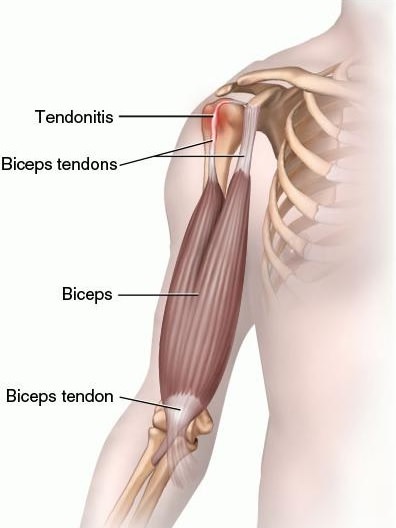Bicipital tendonitis causes shoulder pain due to inflammation of one of the biceps tendons. It is also referred to as tendonitis of the long head of the biceps.
Anatomy of the Biceps Muscle
Biceps means “two heads” as the upper part of the biceps muscle has two parts, known as heads.
The short head originates from a part of the scapula (shoulder blade) called the coracoid process. The long head originates from the top of the shoulder socket and its tendon runs across the head of the humerus to pass down the bicipital groove. The pressure the long head tendon exerts may help stabilise the shoulder head on the socket.
What is Bicipital Tendonitis?
Bicipital tendonitis is inflammation of the tendon of the long head of the biceps muscle. It usually occurs along with other shoulder pathology such as rotator cuff tears, sub-acromial impingement and instability.
What Causes Bicipital Tendonitis?
Repetitive micro trauma may lead to inflammation of the tendon. Typical activities to cause this might be overhead throwing or overhead strokes in racquet sports. As shoulder impingement problems progress to rotator cuff injuries, the biceps tendon commonly becomes involved.
Symptoms of Bicipital Tendonitis
- Pain over the front of the shoulder, sometimes extending down to the biceps muscle.
- A history of overusing the shoulder, e.g. in sport
- Tenderness and pain with pressure over the tendon in its groove.
As this problem typically occurs with other types of shoulder pathology, there are likely to be other symptoms and signs occurring at the same time.
Physiotherapy for Bicipital Tendonitis
Early treatment of acute bicipital tendonitis consists of rest from aggravating activities (such as overhead activities), ice and taking anti-inflammatory medications if recommended by the medical adviser. Physiotherapy will focus on getting pain-free movement of the shoulder with exercises and mobilisations. Strengthening work will then be done for the biceps, rotator cuff muscles and the muscles that stabilise the shoulder blade.
For more troublesome cases doctors can inject steroids along the tendon or operate on the tendon to fix it in its groove so it continues to function but does not move around in the shoulder area.
References:
- Biceps Tendonitis – Medscape – http://emedicine.medscape.com/article/96521-overview
- Tendonitis of the Long Head of the Biceps – OrthoInfo – http://orthoinfo.aaos.org/topic.cfm?topic=a00026
Last Review Date: 25-02-2018
Next Review Date: 25-02-2020

